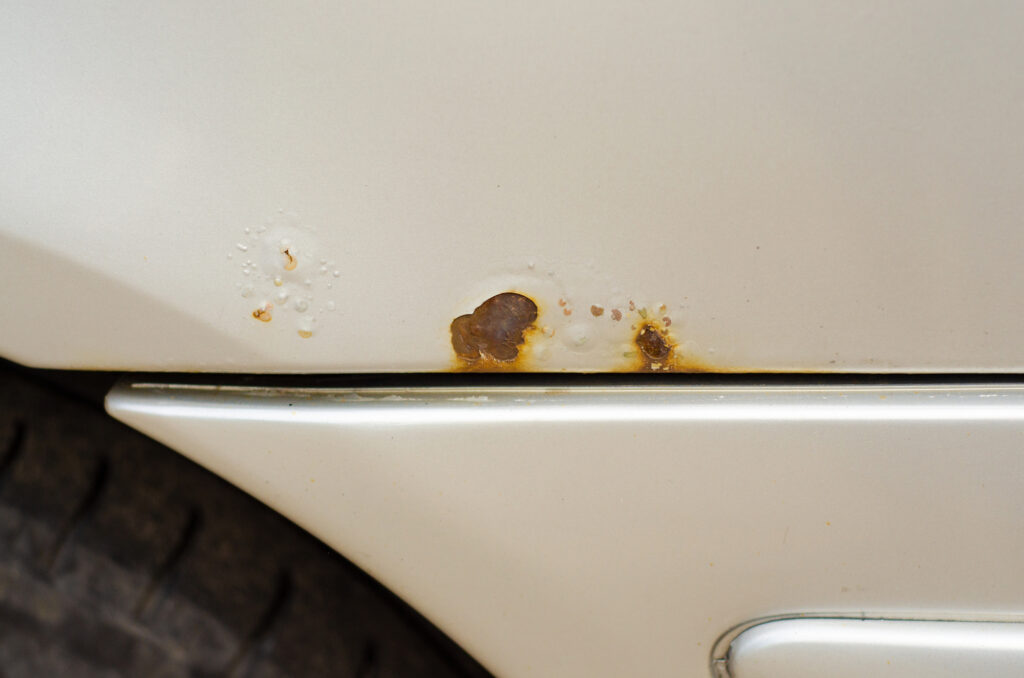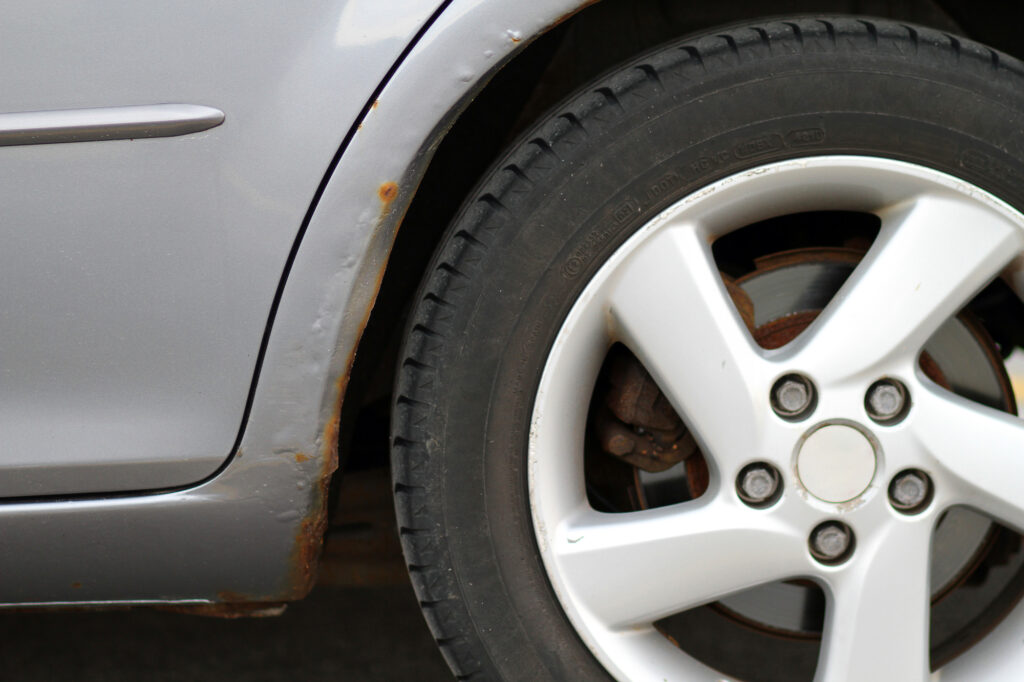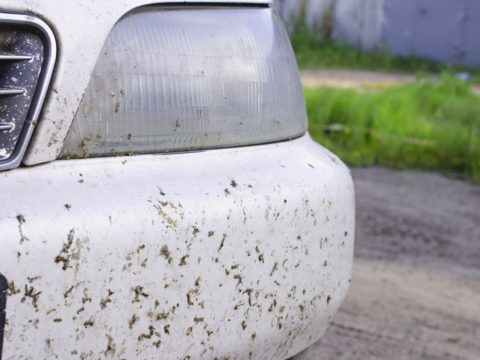If you’ve ever had the unfortunate experience of dealing with rust on your vehicle, you know it’s an unwelcome guest.
Rust is a nuisance and can cause costly damage if left unchecked. Proper rust prevention is essential for anyone who wants to keep their car looking good and functioning correctly.

Today, we’ll explore two of the most popular rust prevention products on the market: Rustoleum Rust Reformer and Por-15 Rust Prevent.
While both effectively convert rust to a stable, paintable surface, Rustoleum Rust Reformer doesn’t have the same staying power as Por-15 Rust Converter. However, it’s a convenient and widely-available option for smaller jobs.
Let’s dive into these two rust conversion paints’ similarities, differences, and best uses.
Contents
Por-15 Rust Converter Overview
Por-15 Rust Preventative is a specialized product that chemically converts rust into a stable compound you can paint over. The automotive, marine, and industrial sectors frequently use it to protect metal surfaces from corrosion.
It is part of a three-part system that consists of Por-15 Cleaner/Degreaser, Por-15 Metal Prep, and POR -15 Rust Preventative Coating, which, when used in conjunction with one another, provides superior adhesion and durability.
Once applied, Por-15 Rust Preventative forms a hard, stable surface resistant to moisture, chipping, peeling, and fading. You can also safely paint over Rust Preventative without affecting its durability.
Overall, Por-15 Rust Preventative is a highly effective product for protecting metal surfaces from corrosion, as it provides a long-lasting finish by bonding directly to the rust.
Rustoleum Overview
Rustoleum Rust Reformer is a two-in-one product that both stops rust from spreading and prevents its return. It acts as a primer and a rust blocker, helping break down existing rust particles and protect the metal beneath them.
This product is excellent for minor rust patches where the damage is manageable.
Using it is as easy as applying the spray paint, letting it penetrate the rust, then painting over it with Rustoleum topcoats for complete protection.
Similarities
Both Por-15 and Rustoleum offer practical solutions for preventing rust and corrosion on metal surfaces.
While the products may have some differences, they share similarities in their intended purpose and effectiveness.
- Rust conversion: Por-15 and Rustoleum contain tannic acid to convert rust into a stable compound you can paint over.
- Versatility: You can use Por-15 and Rustoleum products on various metal surfaces, including vehicles, boats, and industrial equipment.
- Protects against future rust: Besides sealing off existing corrosion, the products further work to prevent moisture from reaching the metal and causing more rust.
Differences
When it comes to Rustoleum and Por-15, there are some differences that you need to be aware of.
Let’s dive into those.
Application Surface
When preparing your surface for Rustoleum rust prevention products, you only need to ensure the surface is clean and free of any loose material. A light scouring with a steel wool pad should be more than enough if the surface is already clean.
Getting a surface ready for Por-15 requires more work than Rustoleum.
It must be completely free of grease, oil, or wax, so you’ll want to start with Por-15 Marine Clean. Follow up with Metal Prep solution to eat through the rust and loosen the oxide layers on metal surfaces.
Recommended Application Temperature
Rustoleum Rust Converter is best applied at temperatures between 65°F (18°C) and 85°F (29°C), whereas Por-15 should be used when temperatures are between 50°F (10°C) and 75°F (24°C).
Both products take up to 24 hours to dry, depending on the temperature and humidity of your workspace, so it’s a good idea to ensure you have enough time when you plan a project using either product.
Cost
Rustoleum is cheaper than Por-15, so it is your best bet if you’re on a budget.
However, it’s important to note that Por-15 provides better results in the long run, while Rustoleum might require more frequent re-applications to sustain its effectiveness.
Formulation
When it comes to Rustoleum vs. Por-15, the most significant difference is in their formulas.
Rustoleum Rust Converter is a water-based latex coating formulated with phosphoric acid and rust-inhibiting chromates.
When applied to rusted metal, it penetrates the rust and forms an iron phosphate surface layer that binds to the metal and provides a base for additional coats of paint.
Por-15 contains ethyl silicate, which forms a flexible bonding film with metal surfaces and prevents oxygen from getting to the surface, effectively sealing out moisture and preventing further corrosion.
It also contains rust-inhibiting pigments that remain effective even as paint coats wear off over time.
Availability
Por-15 is a smaller brand than Rustoleum, and its products may be less widely available.
You can find Rustoleum products at most hardware stores or home improvement centers.
Results
When applied correctly, both products will form an extra layer between your surface and the outside world to protect against rust.
However, if you choose Por-15, your protection will last longer than with Rustoleum.
This product will effectively seal the surface against moisture and oxygen and provide UV protection, which is great if you live somewhere sunny or plan on leaving your newly treated surface exposed for long periods.

Can You Spray Rustoleum Over POR15?
While it is possible to spray Rustoleum over Por-15, it is generally not recommended.
Both Por-15 and Rustoleum are designed to be self-priming and do not require an additional primer layer. Additionally, Por-15 creates a hard, non-porous surface that may not bond well with Rustoleum or other coatings.
If you decide to apply Rustoleum over Por-15, you may need to lightly sand the Por-15 surface to create a rough surface that will allow the Rustoleum to bond correctly.
Pros and Cons Summary
| POR 15 | Rustoleum | ||
| Pros | Cons | Pros | Cons |
| Moisture strengthens the product instead of breaking it down | May have limited availability in your area | Dries very quickly | Not as tough against normal wear and tear |
| Forms a durable, non-porous surface | Does not adhere to smooth surfaces | Once dry, acts as a primer for new coats of paint | Requires surface preparation |
| Available in black, silver, gray, and clear | Requires a multistep process | Spray can is convenient for tackling small, quick repairs | Only available in black |
| Apply with a spray gun, brush, or roller | Prone to UV-damage without a top coat | Affordable | Prone to chipping and impact damage |
So, Which One Is Better Overall?
Ultimately, the choice between rust conversion products comes down to what’s best for you.
Rustoleum is a decent product available almost everywhere and relatively affordable, while Por-15 offers a more robust, longer-lasting solution against rust. Both are excellent rust-prevention products and have a place in car maintenance and repair.
When to Use Por-15
Por-15 is the superior product for serious rust prevention jobs. It goes on thicker than Rustoleum and cures to a much harder layer.
If you’re patching up larger holes in your car’s body or panels, Por-15 is the rust converter for you. It bonds tightly to the surface and won’t flake off as other products might. It’s perfect for larger areas, as you can brush or roll it on.
It’s also ideal for use in extreme conditions—think marine applications, working on vehicles exposed to road salt, or outdoor tools like lawnmowers and chainsaws.
When to Use Rustoleum
You should use Rustoleum if you don’t need rock-solid protection — say, if you’re doing minor rust repair and prevention on an indoor object like a table or chair.
Its versatility and relatively easy application (no special tools required) mean that even beginners can achieve professional-looking results with minimal effort.
Plus, it’s also helpful when your project involves repainting after fixing the rust, as it forms a primer-like layer that is ideal for paint.
Rustoleum’s affordability makes it an excellent choice for DIYers who want to achieve high-quality results without spending too much.
Alternatives
There are several alternatives to Por-15 and Rustoleum for preventing and treating rust on metal surfaces.
Some popular options include:
Corroseal
Corroseal is a water-based rust converter similar to Rustoleum. It acts as a one-step paint, primer, and rust converter, so once applied and cured, you can paint over it for a flawless finish.
KBS Coatings
KBS Coatings offers a range of rust prevention and restoration products, including RustSeal, a rust preventive coating, and RustBlast, a rust remover.
Like Por-15, it requires a 3-step process to clean and prime the metal before applying the rust preventative coat.
Permatex Rust Treatment
The Permatex Rust Treatment works by converting the rust into a protective shield that prevents new rust from forming. It’s easy to apply and dries quickly, making it an ideal option for quick rust repair or prevention jobs.
It’s important to note that the effectiveness of these products may vary depending on the severity and type of rust present, as well as the application method used.
It’s always best to follow the manufacturer’s instructions carefully and test the product on a small area before applying it to a larger surface.














